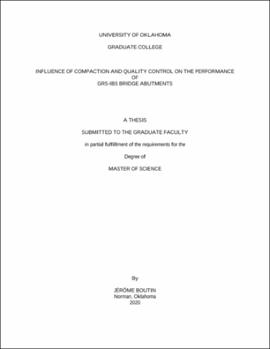| dc.description.abstract | GRS-IBS is a type of bridge abutment that has become more widespread in local and county roads across the United States due to its demonstrated advantages including expedited construction at reduced costs and prevention of the bump-at-end-of-the-bridge problem. Over the last two decades, guidelines have been developed to help with the analysis and design of GRS-IBS. However, influences that factors such as the choice of backfill, and compaction effort could have on the stability and performance of GRS abutments have not been investigated in detail. In this study, three instrumented, full-scale (i.e. 8 ft-tall) model GRS abutments were constructed in an outdoor test facility at the University of Oklahoma to investigate their construction and load-bearing performance as a function of backfill gradation and compaction. These model abutments were part of a longer-term study where influences that other design parameters (including the choice of facing and reinforcement spacing) could have on GRS abutment construction and load-bearing performance have been investigated.
The models in this study were built with CMU blocks for their facing and a woven geotextile for reinforcement, which were placed in the compacted backfill at 8-inch vertical spacing. The backfill type investigated included both an open-graded and a dense-graded aggregate in alternative abutment models. All the component materials used in the models either met or were comparable to the specifications in the Federal Highway Administration’s (FHWA) latest guidelines. The test results from this study were compared with those from a control abutment model with a reduced compaction effort from a recent study by the same research group at OU.
Results of the study indicated significant improvements in the load-bearing capacity and performance of GRS abutments in models with increased compaction effort, consistent with FHWA recommendations. The load-settlement responses of all three abutment models exceeded minimum FHWA requirements by significant margins. It was found that all models could carry surcharge loads of an order of magnitude greater than the FHWA service load of 4 ksf (i.e. 40 ksf) with no more than a maximum of 1.4 inches of settlement at the loading beam simulating the bridge seat. Additionally, facing lateral deformations at the maximum 40 ksf surcharge load level applied to the models were found to be merely 0.25 in, which is nearly half of the limiting value in FHWA guidelines at the significantly smaller load of 4 ksf. Reinforcement strains and axial loads, as calculated from wire potentiometer readings, did not exceed 1.8% and 1,235 lb/ft, respectively. The dense-graded fill showed some improvement over open-graded aggregate, albeit at the expense of significantly longer construction time due to the more challenging compaction procedure. Post-mortem survey of backfill density using the ASTM sand cone method showed that using three compaction passes per lift had resulted in unit weights that well exceeded the required 95% compaction level for GRS abutments in FHWA guidelines. | en_US |
